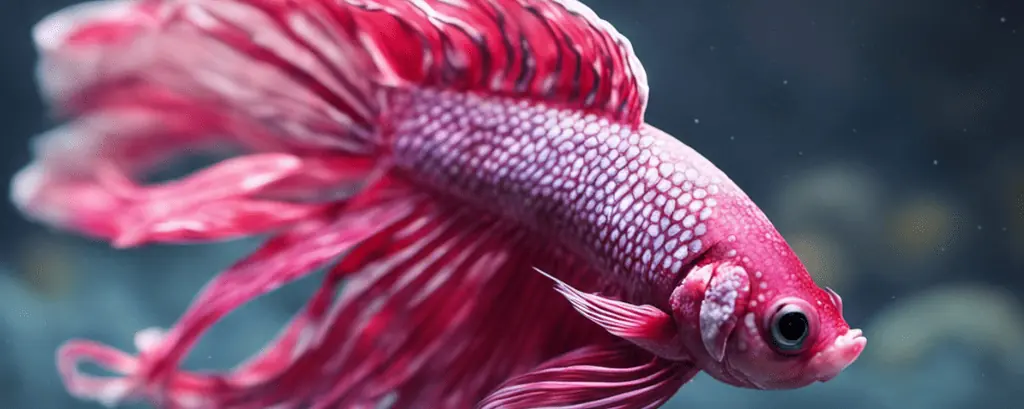Pink betta fish is one of the newest variants created through selective breeding.
This bold color stands out among the more common red and blue colorations.
But pink bettas are not always what they seem.
Some bettas may appear pink in color but do not carry the proper genetics for this hue.
Illness and stress can cause a pink color in bettas, as well.
True pink bettas must have certain genes for their unique color. Breeding for these genes is difficult, making true pink bettas very rare.

Table of Contents
What Is a Pink Betta Fish?
Pink betta fish come in various hues ranging from vivid coral to pastel pink.
These bettas may have a solid pink body, fins, or pink splotches mixed with other bright colors.
Male bettas usually have brighter colors and longer fins than female bettas. But in many pink female bettas, their colors are as vivid as the males.
A pink betta can have any tail type, including:
- Halfmoon
- Rosetail
- Halfmoon plakat
- Veiltail
- Crowntail
- Delta tail
The most common in pink bettas are the halfmoon, delta tail, and halfmoon plakat tail types.
Color Variations

Solid-colored pink bettas are not as common as multi-colored pink bettas.
This is because the demand for multi-colored bettas is much higher.
Betta fish breeders responded to this demand by creating several new and exciting color patterns in pink bettas.
Pink Koi
Pink koi bettas have a white or pale pink body with multi-colored spots. The fins also have streaks of bright colors.
Along with pink, the colors on a pink koi betta’s body include:
- Red
- Orange
- Dark Blue
- Black
Other names for this color variant include “pink candy koi” and “pink galaxy koi.”
These bettas may change color over time due to the marble gene.
Like other koi betta variants, the pink koi betta usually has the halfmoon plakat tail type.
Pink koi bettas are in high demand, making them more expensive than other pink betta color variants.
Pink Orchid
A pink orchid betta has a stunning color pattern with variegated fins.
Pink orchid betta fish have pale pink bodies and a dark burgundy color on the fins.
The burgundy color fades into a band of white at the fin edges.
Many pink orchid bettas have a fin pattern like the butterfly betta with a distinct color band.
Others have streaks of burgundy on their white fins.
Pink Pineapple
Pink pineapple bettas are the most flamboyant pink color variation.
These bettas have light pink bodies with black outlines around the scales.
Orange is a prominent color on the head and fins.
Pastel blue, yellow, and white streaks give the fins a watercolor look.
The over-halfmoon tail type is the most common in pink pineapple bettas. These large, flowy fins showcase the beautiful colors of these bettas.
Many pink pineapple bettas also have the elephant ear trait.
All these features combined make this pink color variant expensive.
Are Pink Betta Fish Rare?

The pink betta fish is one of the rarest color variations available.
Due to their complicated genetics, achieving a true pink in bettas is difficult.
You may have trouble finding solid pink or pink koi and pineapple bettas at your local pet store.
But as pink orchid bettas become more popular, some fish stores may have them.
If you cannot find these pink fish locally, several online breeders sell pink bettas and their variations.
You must beware of false advertising from online breeders, though.
Irrefutable breeders may enhance their betta’s pink colors with special lighting or photo editing.
These enhancements can make the betta appear more pink than it really is.
Some of these breeders even use pink betta fish stock pictures as a placeholder for their listings.
If the breeder cannot provide actual photos of the bettas they sell, steer clear and look somewhere else.
Reading reviews also help you learn more about a breeder’s reputation.
Average Cost of a Pink Betta Fish
The average price for most pink betta fish is $25-$40.
A pink betta’s fin type and color pattern affect its price.
Pink pineapple bettas cost a bit more, with an average price of $45.
The pink koi betta has the highest price range of $60 to $65.
You must also factor in the shipping cost when buying a pink betta from an online breeder.
Most breeders charge between $15 to $20 for shipping their bettas.
This price covers overnight shipping in a special container, so the betta stays safe.
Avoid buying your betta from an online breeder during extreme temperatures.
Reputable breeders take special precautions to ensure the safety of their bettas during shipping.
But any shipping delays in very hot or freezing weather lowers your betta’s chance of survival.
The Breeding History of Pink Betta Fish

There is not much information about the origin of pink betta fish.
Pink colors do not exist in wild betta splendens.
Developing pink betta fish likely took years of careful breeding.
Breeding pink bettas is more complicated than breeding bettas with other colors.
There is no single gene responsible for the pink appearance in bettas.
A pink betta must have the right combination of genes from different color layers.
Many of these genes are recessive. This complicates the breeding process even further.
Breeding a pink male betta and a pink female betta does not always produce pink offspring.
Betta Color Gen etics
Captive-bred bettas have four color layers of pigment cells:
- Iridescent
- Black
- Red
- Yellow
The iridescent layer controls the iridescent sheen and blue pigment in bettas.
A non-blue gene does not exist. But the combination of steel blue and normal iridescence makes a betta look silver instead of blue.
Cambodian and blonde/bright pigments exist on the black color layer.
The Cambodian pigment cells produce a betta with a pale pink body and red fins.
Blonde/bright pigment cells create pastel or washed-out colors. These pigment cells can give red a pinkish tinge.
Pink bettas likely have a combination of Cambodian and blonde/bright pigment cells.
The red layer controls how much red pigment covers a betta’s body.
For example, extended red pigments cover the entire body and fins. Reduced red pigments only produce red on the fins.
Variegated fin genes are also on the red layer. These genes appear in the pink orchid betta.
The yellow layer does not control yellow pigment. Instead, the yellow layer controls the opaque genes.
Opaque genes create pastel versions of other colors by creating a white pigment underneath.
If bettas lack opaque pigment cells, they have translucent bodies and fins.
Pink bettas may have some degree of opaque pigment cells. These cells can make red colors a pastel pink shade.
A pink koi betta also has a special trait called marble genes.
Marble genes can turn other pigment cells on and off, making a betta change colors over time.
Depending on how active marble genes are, a betta may change colors several times during its life.
Some Bettas Are Not Truly Pink

There are several strains of bettas with a pink appearance.
But many of these bettas are not genuine pink bettas because they do not have the right genetics.
Some of these bettas only look pink in certain lighting.
Albino Betta
Albino betta fish do not have any pigments, including in their eyes.
Due to the lack of pigment, albino bettas are more prone to blindness and skin cancer.
These bettas have a body with a pinkish tinge.
But this is only because the betta’s blood vessels and internal organs show through their translucent skin.
Cellophane Betta
Cellophane betta fish are sometimes confused with albino bettas.
While the cellophane betta also has a translucent body and fins, they are not without pigments.
These bettas have black eyes instead of the red or pink eyes seen in albino bettas.
A cellophane betta’s body appears pink because of its visible organs and blood vessels.
Cellophane bettas also have some form of iridescent pigments.
White Betta
If a white betta has iridescent pigment, it can look pink in aquarium lighting.
White opal bettas have this iridescence on their bodies and fins. Besides pink, these bettas can appear pastel green or blue.
Platinum bettas have a metallic sheen instead of true iridescence. A platinum betta looks white or silver in any light.
Cambodian Betta
A Cambodian betta has a pale pink or flesh-colored body and red fins.
Blue Cambodian bettas also exist, but they are very rare.
The Cambodian betta is not classified as a true pink betta, even though they usually have pink bodies.
But many genuine pink bettas have Cambodian genes.
Other Reasons a Betta May Appear Pink

Besides genetics, there are several reasons why a colorful betta fish may appear pink.
In these instances, the pink appearance is usually a temporary side effect.
Young Age
Juvenile betta fish do not gain true colors until they reach sexual maturity.
Red juvenile bettas have pale pink colors. This pink color darkens to red as they approach breeding age.
Most bettas sold in pet stores are at least one year of age.
They have already transformed into their adult color.
Old Age
A betta’s color fades as it reaches old age.
This fading process starts at the betta’s fins and spreads to the head and body.
Your bright red betta may end up as a pink fish as it nears the end of its lifespan.
Since bettas have an average lifespan of 3-5 years, you may notice fading colors any time after your fish reaches three years old.
Illness
Common fish diseases can make your betta develop a pale color.
If your young red betta starts fading to pink, check for symptoms of illness.
Bacterial and fungal infections are the leading causes of fading colors in bettas.
This is a temporary color change.
The bright colors return once you treat your betta’s illness and it recovers.
Stress
Stress is another reason a betta’s color can fade. Your brilliant crimson betta may fade into a pale pink color.
A stressed betta may also develop stress stripes.
These horizontal stress stripes appear on the sides of a betta’s body.
Stress stripes are usually red but are sometimes black, white, or pink.
Female betta fish also develop these stripes during the breeding process.
These stripes disappear in the female after spawning.
Prolonged stress weakens a betta’s immune system. This makes the fish more prone to illness.
Common causes of stress include:
- Poor water conditions
- Improper water parameters
- Overcrowding
- Aggressive tank mates
Our article on the causes of betta stress stripes provides helpful information on preventing them.
After you resolve the cause of your betta’s stress, its color returns to normal.


